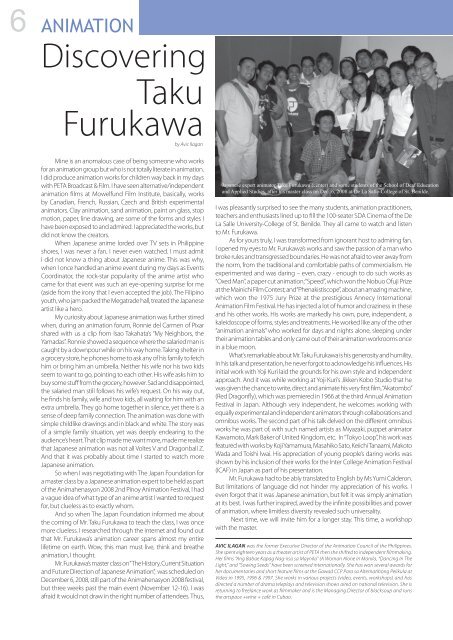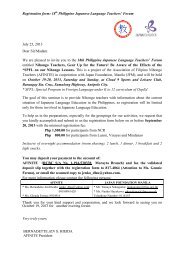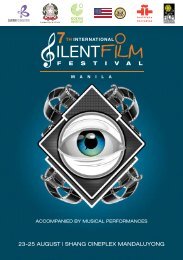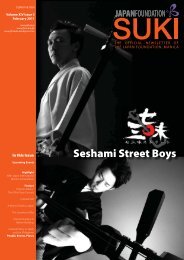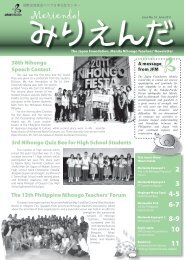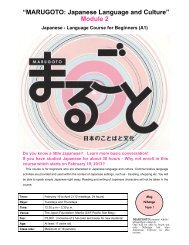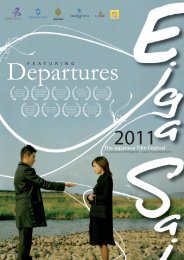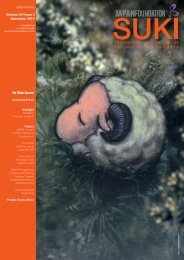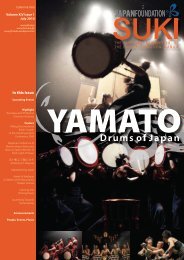In this Issue - The Japan Foundation, Manila
In this Issue - The Japan Foundation, Manila
In this Issue - The Japan Foundation, Manila
- No tags were found...
Create successful ePaper yourself
Turn your PDF publications into a flip-book with our unique Google optimized e-Paper software.
ANIMATIONDiscoveringTakuFurukawaby Avic IlaganMine is an anomalous case of being someone who worksfor an animation group but who is not totally literate in animation.I did produce animation works for children way back in my dayswith PETA Broadcast & Film. I have seen alternative/independentanimation films at Mowelfund Film <strong>In</strong>stitute, basically, worksby Canadian, French, Russian, Czech and British experimentalanimators. Clay animation, sand animation, paint on glass, stopmotion, paper, line drawing, are some of the forms and styles Ihave been exposed to and admired. I appreciated the works, butdid not know the creators.When <strong>Japan</strong>ese anime lorded over TV sets in Philippineshores, I was never a fan. I never even watched. I must admitI did not know a thing about <strong>Japan</strong>ese anime. This was why,when I once handled an anime event during my days as EventsCoordinator, the rock-star popularity of the anime artist whocame for that event was such an eye-opening surprise for me(aside from the irony that I even accepted the job). <strong>The</strong> Filipinoyouth, who jam packed the Megatrade hall, treated the <strong>Japan</strong>eseartist like a hero.My curiosity about <strong>Japan</strong>ese animation was further stirredwhen, during an animation forum, Ronnie del Carmen of Pixarshared with us a clip from Isao Takahata’s “My Neighbors, theYamadas”. Ronnie showed a sequence where the salaried man iscaught by a downpour while on his way home. Taking shelter ina grocery store, he phones home to ask any of his family to fetchhim or bring him an umbrella. Neither his wife nor his two kidsseem to want to go, pointing to each other. His wife asks him tobuy some stuff from the grocery, however. Sad and disappointed,the salaried man still follows his wife’s request. On his way out,he finds his family, wife and two kids, all waiting for him with anextra umbrella. <strong>The</strong>y go home together in silence, yet there is asense of deep family connection. <strong>The</strong> animation was done withsimple childlike drawings and in black and white. <strong>The</strong> story wasof a simple family situation, yet was deeply endearing to theaudience’s heart. That clip made me want more, made me realizethat <strong>Japan</strong>ese animation was not all Voltes V and Dragonball Z.And that it was probably about time I started to watch more<strong>Japan</strong>ese animation.So when I was negotiating with <strong>The</strong> <strong>Japan</strong> <strong>Foundation</strong> fora master class by a <strong>Japan</strong>ese animation expert to be held as partof the Animahenasyon 2008 2nd Pinoy Animation Festival, I hada vague idea of what type of an anime artist I wanted to requestfor, but clueless as to exactly whom.And so when <strong>The</strong> <strong>Japan</strong> <strong>Foundation</strong> informed me aboutthe coming of Mr. Taku Furukawa to teach the class, I was oncemore clueless. I researched through the internet and found outthat Mr. Furukawa’s animation career spans almost my entirelifetime on earth. Wow, <strong>this</strong> man must live, think and breatheanimation, I thought.Mr. Furukawa’s master class on “<strong>The</strong> History, Current Situationand Future Direction of <strong>Japan</strong>ese Animation”, was scheduled onDecember 6, 2008, still part of the Animahenasyon 2008 festival,but three weeks past the main event (November 12-16). I wasafraid it would not draw in the right number of attendees. Thus,<strong>Japan</strong>ese expert animator Taku Furukawa (center) and some students of the School of Deaf Educationand Applied Studies, after his master class on Dec. 6, 2008 at De La Salle-College of St. Benilde.I was pleasantly surprised to see the many students, animation practitioners,teachers and enthusiasts lined up to fill the 100-seater SDA Cinema of the DeLa Salle University-College of St. Benilde. <strong>The</strong>y all came to watch and listento Mr. Furukawa.As for yours truly, I was transformed from ignorant host to admiring fan.I opened my eyes to Mr. Furukawa’s works and saw the passion of a man whobroke rules and transgressed boundaries. He was not afraid to veer away fromthe norm, from the traditional and comfortable paths of commercialism. Heexperimented and was daring – even, crazy - enough to do such works as“Oxed Man”, a paper cut animation; “Speed”, which won the Nobuo Ofuji Prizeat the Mainichi Film Contest; and “Phenakistiscope”, about an amazing machine,which won the 1975 Jury Prize at the prestigious Annecy <strong>In</strong>ternationalAnimation Film Festival. He has injected a lot of humor and craziness in theseand his other works. His works are markedly his own, pure, independent, akaleidoscope of forms, styles and treatments. He worked like any of the other“animation animals” who worked for days and nights alone, sleeping undertheir animation tables and only came out of their animation workrooms oncein a blue moon.What’s remarkable about Mr. Taku Furukawa is his generosity and humility.<strong>In</strong> his talk and presentation, he never forgot to acknowledge his influences. Hisinitial work with Yoji Kuri laid the grounds for his own style and independentapproach. And it was while working at Yoji Kuri’s Jikken Kobo Studio that hewas given the chance to write, direct and animate his very first film, “Akatombo”(Red Dragonfly), which was premiered in 1966 at the third Annual AnimationFestival in <strong>Japan</strong>. Although very independent, he welcomes working withequally experimental and independent animators through collaborations andomnibus works. <strong>The</strong> second part of his talk delved on the different omnibusworks he was part of, with such named artists as Miyazaki, puppet animatorKawamoto, Mark Baker of United Kingdom, etc. <strong>In</strong> “Tokyo Loop”, his work wasfeatured with works by Koji Yamamura, Masahiko Sato, Keiichi Tanaami, MakotoWada and Toishi Iwai. His appreciation of young people’s daring works wasshown by his inclusion of their works for the <strong>In</strong>ter College Animation Festival(ICAF) in <strong>Japan</strong> as part of his presentation.Mr. Furukawa had to be ably translated to English by Ms Yumi Calderon.But limitations of language did not hinder my appreciation of his works. Ieven forgot that it was <strong>Japan</strong>ese animation, but felt it was simply animationat its best. I was further inspired, awed by the infinite possibilities and powerof animation, where limitless diversity revealed such universality.Next time, we will invite him for a longer stay. This time, a workshopwith the master.AVIC ILAGAN was the former Executive Director of the Animation Council of the Philippines.She spent eighteen years as a theater artist of PETA then she shifted to independent filmmaking.Her films “Ang Babae Kapag Nag-iisa sa Maynila” (A Woman Alone in <strong>Manila</strong>, “Dancing <strong>In</strong> <strong>The</strong>Light,” and “Sowing Seeds” have been screened internationally. She has won several awards forher documentaries and short feature films at the Gawad CCP Para sa Alternatibong Pelikula atVideo in 1995, 1996 & 1997. She works in various projects (video, events, workshops) and hasdirected a number of drama teleplays and television shows aired on national television. She isreturning to freelance work as filmmaker and is the Managing Director of blacksoup and runsthe artspace +wine + café in Cubao.


